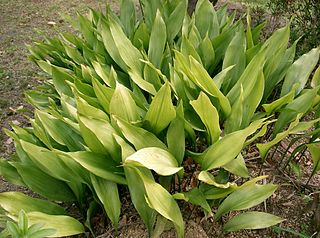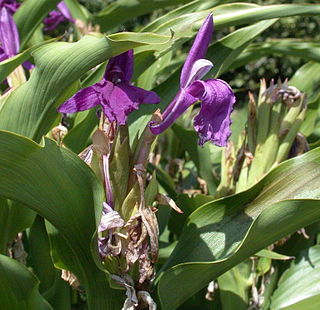
Zingiberaceae or the ginger family is a family of flowering plants made up of about 50 genera with a total of about 1600 known species of aromatic perennial herbs with creeping horizontal or tuberous rhizomes distributed throughout tropical Africa, Asia, and the Americas. Many of the family's species are important ornamental, spice, or medicinal plants. Ornamental genera include the shell gingers (Alpinia), Siam or summer tulip, Globba, ginger lily (Hedychium), Kaempferia, torch-ginger Etlingera elatior, Renealmia, and ginger (Zingiber). Spices include ginger (Zingiber), galangal or Thai ginger, melegueta pepper, myoga, korarima, turmeric (Curcuma), and cardamom.

Amomum subulatum, also known as black cardamom, hill cardamom, Bengal cardamom, greater cardamom, Indian cardamom, Nepal cardamom, winged cardamom, big cardamon, or brown cardamom, is a perennial herbaceous plant in the family Zingiberaceae. Its seed pods have a strong, camphor-like flavour, with a smoky character derived from the method of drying. In Hindi it is called बड़ी इलाइची.

Aspidistra is a genus of flowering plants in the family Asparagaceae, subfamily Nolinoideae, native to eastern and southeastern Asia, particularly China and Vietnam. They grow in shade under trees and shrubs. Their leaves arise more or less directly from ground level, where their flowers also appear. The number of species known has increased considerably from the 1980s onwards, with around 100 accepted as of July 2013. Aspidistra elatior is common worldwide as a foliage house plant that is very tolerant of neglect. It and other species can also be grown in shade outside, where they are generally hardy to −5 °C (23 °F).

Alpinia is a genus of flowering plants in the ginger family, Zingiberaceae. Species are native to Asia, Australia, and the Pacific Islands, where they occur in tropical and subtropical climates. Several species are cultivated as ornamental plants.

Zingiber is a genus of flowering plants in the family Zingiberaceae. It is native to Southeast Asia, especially in Thailand, China, the Indian Subcontinent, and New Guinea. It contains the true gingers, plants grown the world over for their culinary value. The most well known species are Z. officinale and Z. mioga, two garden gingers.

Curcuma is a genus of plants in the family Zingiberaceae that contains such species as turmeric and Siam tulip. They are native to Southeast Asia, southern China, the Indian Subcontinent, New Guinea and northern Australia. Some species are reportedly naturalized in other warm parts of the world such as tropical Africa, Central America, Florida, and various islands of the Pacific, Indian and Atlantic Oceans. Generally, most curcuma grows well in loose and sandy soil in shaded areas.

Amomum is a genus of plants native to China, the Indian subcontinent, Southeast Asia, New Guinea, and Queensland. It includes several species of cardamom, especially black cardamom. Plants of this genus are remarkable for their pungency and aromatic properties.

Roscoea is a genus of perennial plants of the family Zingiberaceae. While most members of the ginger family are tropical, Roscoea species are native to cooler mountainous regions of the Himalayas, China and its southern neighbours. Roscoea flowers superficially resemble orchids, although they are not related. The flowers of Roscoea have a complicated structure, in which some of the showy coloured parts are not formed by petals, but by staminodes, sterile stamens which have evolved to resemble petals. Some species are grown as ornamental plants in gardens.

Lanxangia tsaoko, formerly Amomum tsao-ko, and also known as black cardamom, is a ginger-like plant known in English by the transliterated Chinese name. It grows at high altitudes in Yunnan, as well as the northern highlands of Vietnam. Both wild and cultivated plants are used medicinally and also in cooking. The dried fruit of the plant has a pungent, gingery taste.
Rubovietnamia is a genus of plants in the family Rubiaceae, native to Vietnam, southern China and the Philippines.
Meistera is an Asian genus of plants in the family Zingiberaceae. Species have been recorded from Tropical & Subtropical Asia to northern Queensland.

Wurfbainia is an Asian genus of plants in the family Zingiberaceae. Species have been recorded from the Himalayas, S. China, Indo-China and W. & Central Malesia. It has previously been placed as a synonym of Amomum.
Conamomum is a genus of flowering plants in the family Zingiberaceae and tribe Alpinieae. Its native range is from Indochina to western Malesia.

Boesenbergia is a genus of plants in the ginger family. It contains more than 90 species, native to China, the Indian Subcontinent, and Southeast Asia.
Distichochlamys is a genus of plants in the ginger family. It has 4 known species, all endemic to Vietnam.
Epiamomum is a genus of plants in the family Zingiberaceae and tribe Alpinieae; all records to date are from Borneo island. Before 2018, some species were placed in the genus Amomum.
Loxostigma is a genus of flowering plants belonging to the family Gesneriaceae.
Aristolochia fangchi, is a species of flowering plant in the family Aristolochiaceae, native to Vietnam and southeast and south-central China.
Newmania is a genus of rhizomatous based flowering plants belonging to the family Zingiberaceae. They are only native to Vietnam, and found in forests.











